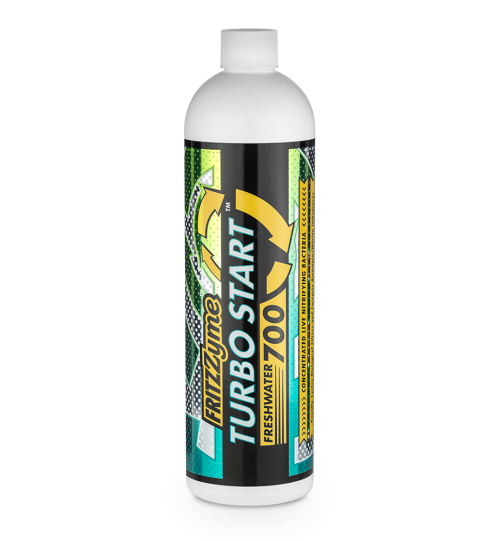About FritzZyme® TurboStart® 700 Freshwater
FritzZyme® TurboStart® 700 contains the same proven freshwater strains of effective, live nitrifying bacteria as FritzZyme® 7 but at 15 times the concentration. TurboStart® 700 reduces fish loss due to toxic levels of ammonia and nitrite. Establishing colonies of nitrifying bacteria without FritzZyme® can take weeks; FritzZyme® TurboStart® completely cycles aquariums in five days or less, allowing for safe, immediate addition of livestock.
TurboStart® may be added to new tanks or established systems any time the biofilter needs fortification, including after water changes, aggressive cleaning, adding new livestock, medicating or changing filter media.
Why add nitrifying bacteria?
Nitrifying bacteria can take weeks to naturally establish colonies in new aquariums while ammonia and nitrite can reach lethal levels in only a few days. FritzZyme® Live Nitrifying Bacteria provides the species of bacteria proven by professional zoos, aquariums, universities, and aquaculture facilities to rapidly seed biofilters. FritzZyme® quickly removes toxic ammonia and nitrite in existing systems and greatly reduces cycle time allowing for safe, immediate addition of livestock in new systems. FritzZyme* Nitrifying bacteria may also be added any time the bio-filter needs fortification including after water changes, aggressive cleaning, adding new livestock, medicating, or changing filter media.
Live, Viable Product
Unlike some heterotrophic bacteria, which can survive in a long-term spore state, only true nitrifying bacteria can cycle an aquarium. True nitrifying bacteria are fragile and temperature-sensitive, which is difficult to produce and package. FritzZyme® TurboStart® is the most concentrated product on the market. Every bottle of TurboStart® 700 has an expiration date and a 6-month refrigerated shelf life to ensure viable, effective product.
Years of Proven Success
Fritz Aquatics has been continuously producing the highest quality, viable, nitrifying bacteria for over 30 years and was the first company to commercially produce nitrifying bacteria for the aquarium industry. Fritz Aquatics has remained a leader in the industry with continuous research, production, and development. There are very few producers of true live nitrifying bacteria, none of which can match the experience and success of FritzZyme®.
Need help? Try our FritzZyme user guide!
Directions & Dosage
For new systems, dose 1 oz (29 mL) per 50 US gallons (189 L). Shake well before dosing. To decrease cycling time, FritzZyme® TurboStart® 700 can be safely used up to 5x recommended dosage.
Need help? Try our FritzZyme user guide!
- For best results, maintain ideal water parameters noted below and use FritzZyme® TurboStart 700 before the expiration date on the package
- All chlorine and chloramines must be removed from water before adding FritzZyme® TurboStart 700
- Nitrifying bacteria require ammonia and nitrite to survive; in new systems introduce livestock or another ammonia source like Fishless Fuel to start cycling
- Maintain adequate water flow or aeration
- Discontinue use of skimmer and UV sterilizers for at least 5 days after application
- Store refrigerated
- No contraindications: can be used with all of our other products and meds
- Safe for use with all species, including plants and invertebrates
- Safe to add directly into a tank with livestock present
- Systems may be slightly cloudy or have an earthy odor for several hours after treatment
- Variations of odor and color between bottles is normal, a strong sulfur smell does not mean the bacteria are dead
- Do not freeze or overheat. Store in a cool, dark place
- Overdosed? Live nitrifying bacteria are very safe even if overdosed. Observe for any distress, perform small water changes if necessary
Ideal parameters for FritzZyme® TurboStart 700 nitrifying bacteria:
Temperature: 77-86 F (25-30 C)
pH: 7.3-8.0; nitrification is completely inhibited below pH 6.0
Salinity: 0 - 6 ppt (1.000 to 1.0045 sg); active up to 15 ppt (1.011 sg)
Alkalinity (KH): minimum 4.5 dKH or 80.5 ppm KH
Phosphate: above 0 ppm
Sizes
| Size | Treats | Item Number |
|---|---|---|
| 1 gal / 3.8 L | 6,400 gal / 24,226 L | 80503 |
| 1 oz / 30 mL | 50 gal / 189 L | 80510 |
| 4 oz / 118 mL | 200 gal / 757 L | 80513 |
| 16 oz / 473 mL | 800 gal / 3,028 L | 80515 |
| 32 oz / 946 mL | 1,600 gal / 6,057 L | 80518 |
FAQs
FAQs
See below for frequently asked questions regarding FritzZyme® TurboStart® 700 Freshwater.
- How soon may I stock my tank with a full load of fish?
- My nitrites won’t go down after weeks of cycling. Will TurboStart help me get rid of the nitrites?
- How do I store Turbo Start?
- I use Eco Complete substrate is FritzZyme TurboStart 700 compatible with this substrate?
- Does the color or smell change the effectiveness or remaining shelf life of FritzZyme® Nitrifying Bacteria?
- Why does it take so long for an aquarium to cycle without FritzZyme® Nitrifying Bacteria?
- How long has Fritz Industries, Inc. been working with nitrifying bacteria?
- Do I need to add an initial ammonia source for the nitrifying bacteria of a new tank?
- How does FritzZyme® Nitrifying Bacteria work?
- How does FritzZyme® Nitrifying Bacteria compare to other products?
- How can I tell if the FritzZyme® Nitrifying Bacteria has spoiled?
- Can I use copper medications with FritzZyme® in my marine aquarium?
- What products should not be used with FritzZyme®?
- How often should I use FritzZyme® Nitrifying Bacteria?
- Can I use chemical ammonia removers with FritzZyme® Nitrifying Bacteria?
- Do you need a weekly dose every week with FritzZyme® Nitrifying Bacteria?
- What levels of ammonia and nitrite should I see when using FritzZyme® Nitrifying Bacteria?
- What if my nitrites will not go down in my freshwater aquarium treated with FritzZyme® Nitrifying Bacteria?
- What other products may be used with FritzZyme®?
Submit a Question
Can't find what you're looking for? Ask us a new question.
